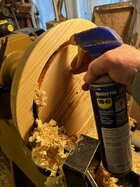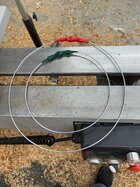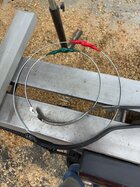I got mine about a month ago. I finally got a few logs to try it out on. I was very impressed. Very first core came out right at the depth I wanted. All of the bowls were the same diameter but some were deeper than others. I was able to adjust it to core the same width but not as deep. A friend of mine with the Oneway said he can’t do that with his. I heard a lot of horror stories about learning curve and problems but I thought it was very easy to use and accurate right out of the box. A friend gave me three Mamosa logs and I cored out six bowls.
-
Beware of Counterfeit Woodturning Tools (click here for details) -
Johnathan Silwones is starting a new AAW chapter, Southern Alleghenies Woodturners, in Johnstown, PA. (click here for details) -
Congratulations to Peter Jacobson for "Red Winged Burl Bowl" being selected as Turning of the Week for April 29, 2024 (click here for details) -
Welcome new registering member. Your username must be your real First and Last name (for example: John Doe). "Screen names" and "handles" are not allowed and your registration will be deleted if you don't use your real name. Also, do not use all caps nor all lower case.
You are using an out of date browser. It may not display this or other websites correctly.
You should upgrade or use an alternative browser.
You should upgrade or use an alternative browser.
McNaughton bowl coring system.
- Thread starter Rusty Nesmith
- Start date
Rusty, I also use the McNaughton and started out a bit slower (steeper curve) than you, but now feel that I’ve pretty much got it. Not sure where I heard it - likely on this forum, since this is where I get most of my tips, but if you ever find things going too slowly as you get down towards the bottom of the curve, and you can’t solve it by adjusting the arc of the cutter, a shot of WD-40 in the groove can greatly ease the cut.

Thanks Lou I will have to remember that.
I thought each successive bowl was a smaller diameterAll of the bowls were the same diameter
They are if you have a big enough log. My logs were big enough to get one bowl each.I thought each successive bowl was a smaller diameter
Yep - whatever system you use, getting more from every blank than just shavings to sweep up is a definite benefit. I’ve been using the Macnaughton for almost two decades, core every bowl blank I rough. Once you get a feel for how the entry angle establishes the bottom, everything else is simple. I always work from large to small and seldom need more than three cores from a blank.
I received a used McNaughton a couple months ago. Once I learned the angle to start, I've been a coring SOB ever since! Love it! I have zero experience with the other brand coring systems. I purchased the McNaughton due to the versatility that I always heard about.
I got to watch Mike Mahoney at the last Oregon Woodturning Symposium here and he made an interesting comment. He said that he did over 90% of his coring with the medium curve blade. Me too, and we had not chatted about that before. I do grind my points off square rather than the 'spear' point, which was a Mike improvement, especially since the first sets were dog eared off to one side rather than centered on the blade. When Mike cores, he 'fishtails' which means he wiggles it a bit side to side as he cores. This opens up the kerf a bit. The problem I had with that was that I seemed to get a lot more clogging up in the kerf when I did that compared to when I just went straight in.
For setting the height of the coring blades, they tell you to use the longest blade you have and adjust till you are at center height. I actually have mine set 1/4 to 1/2 inch above that. The reason is that there is a lot of flex designed into the system. If you have ever tried to remove the tenon stub in the bottom of a cored bowl, first thing that happens is that the blade drops as much as half an inch. I got so I could 'feel' when the blade was below center, and this was a constant problem, so I made a collar to go around the tool rest to keep it at constant height and that height is above center to compensate for the flex. If you start getting catches near the bottom of your core, this is one likely problem.
If you are going through the bottom of a bowl, the main issue is that you went parallel to the side of the bowl rather than going in a bit. I lay the blade up against the outside of the bowl. If the arc of the bowl and the arc of the blade are pretty much the same, and if you try to match the curve of the bowl wall, you will put notches in the jaws of your chuck. I have a couple that have bite marks.... I saw one video, I think the turner's name was Brown, and he put pencil marks on the outside of the bowl to mark the desired depth he wanted for each of his cores. That seemed to be a good idea to me.
I do use lubricant on the blades some times. Mostly the Slick Stick from Woodturners Wonders. Great stuff, and it does wonders on the sole of your hand planes. I have heard of all sorts of different things being used, including Pam the vegetable spray. Some woods just have more sticky stuff in them than others, and that is when I use lubricant.
The biggest problem with the blades is that they do not follow a perfect arc of the curve. My guess is that they are profiled, as in rounding over the edges top and bottom first, then they are bent. In researching getting 'perfect' circle arcs, they will bend a much bigger length, like 4 to 5 inches, and then snip off the extra. Kel insists that they are 'spot on' but you don't have to look very closely to see that they are not, and the last inch or 2 goes pretty much straight. If you can't see it, you can lay it on a plastic circle template and it is obvious. I can't think of any way to get the perfect curve in my blades other than heating it with a torch and bending it a bit more. Not sure what that would do to the laminated cutting material on the tip. I was able to take one old blade and 'armstrong' it in a vide to get a little more bend, and I bent it a bit more than needed, so it actually tracked a bit to the inside. The blades as they come ALWAYS drift to the outside of the kerf. I have burned my fingers a number of times by handling the blade as I withdraw it, and more times than I can count, I get that burned edge on the bowl blank from heat/friction. I have thought about making my own blades and making sure they are perfect arcs of the curve. Just haven't gotten 'a round 2 it' yet. I did retip a couple of blades with some tantung, and it works well.
For sharpening them, a coarse, like 220 or more diamond card. They are scrapers, and they work better with a burr, on most woods anyway.
robo hippy
For setting the height of the coring blades, they tell you to use the longest blade you have and adjust till you are at center height. I actually have mine set 1/4 to 1/2 inch above that. The reason is that there is a lot of flex designed into the system. If you have ever tried to remove the tenon stub in the bottom of a cored bowl, first thing that happens is that the blade drops as much as half an inch. I got so I could 'feel' when the blade was below center, and this was a constant problem, so I made a collar to go around the tool rest to keep it at constant height and that height is above center to compensate for the flex. If you start getting catches near the bottom of your core, this is one likely problem.
If you are going through the bottom of a bowl, the main issue is that you went parallel to the side of the bowl rather than going in a bit. I lay the blade up against the outside of the bowl. If the arc of the bowl and the arc of the blade are pretty much the same, and if you try to match the curve of the bowl wall, you will put notches in the jaws of your chuck. I have a couple that have bite marks.... I saw one video, I think the turner's name was Brown, and he put pencil marks on the outside of the bowl to mark the desired depth he wanted for each of his cores. That seemed to be a good idea to me.
I do use lubricant on the blades some times. Mostly the Slick Stick from Woodturners Wonders. Great stuff, and it does wonders on the sole of your hand planes. I have heard of all sorts of different things being used, including Pam the vegetable spray. Some woods just have more sticky stuff in them than others, and that is when I use lubricant.
The biggest problem with the blades is that they do not follow a perfect arc of the curve. My guess is that they are profiled, as in rounding over the edges top and bottom first, then they are bent. In researching getting 'perfect' circle arcs, they will bend a much bigger length, like 4 to 5 inches, and then snip off the extra. Kel insists that they are 'spot on' but you don't have to look very closely to see that they are not, and the last inch or 2 goes pretty much straight. If you can't see it, you can lay it on a plastic circle template and it is obvious. I can't think of any way to get the perfect curve in my blades other than heating it with a torch and bending it a bit more. Not sure what that would do to the laminated cutting material on the tip. I was able to take one old blade and 'armstrong' it in a vide to get a little more bend, and I bent it a bit more than needed, so it actually tracked a bit to the inside. The blades as they come ALWAYS drift to the outside of the kerf. I have burned my fingers a number of times by handling the blade as I withdraw it, and more times than I can count, I get that burned edge on the bowl blank from heat/friction. I have thought about making my own blades and making sure they are perfect arcs of the curve. Just haven't gotten 'a round 2 it' yet. I did retip a couple of blades with some tantung, and it works well.
For sharpening them, a coarse, like 220 or more diamond card. They are scrapers, and they work better with a burr, on most woods anyway.
robo hippy
I have had my McNaughten Bowl coring for a couple years.
I have observed
- it works much better with green wood
-it can easily beak off a seemingly stout tenon if less than .25 of the dia. The reason I bought a titan II for 6" grip (after some sphincter tightening events)
-Knots are not your friend
-seems to be much faster setup and compact storage than Oneway etc
-after some learning curve, coring a bowl is only a little more time consuming than gouging it out.
I have observed
- it works much better with green wood
-it can easily beak off a seemingly stout tenon if less than .25 of the dia. The reason I bought a titan II for 6" grip (after some sphincter tightening events)
-Knots are not your friend
-seems to be much faster setup and compact storage than Oneway etc
-after some learning curve, coring a bowl is only a little more time consuming than gouging it out.
I’ll have to try this Rusty. I’ve gotten to the point that I can usually get pretty close, but occasionally err on the side of a too shallow core as I cut conservatively to keep from going through the bottom. Your suggestion sounds like a neat solution.I bent some wire to match the curve of the cutters. I hold the wire at the depth and where I want the cut to start. I match the cutter to the wire and lock down the banjo. It cuts exactly where you want it to.
- Joined
- Apr 27, 2004
- Messages
- 8,652
- Likes
- 5,014
- Location
- Lakeland, Florida
- Website
- www.hockenberywoodturning.com
That is a nice system!bent some wire to match the curve of the cutters. I hold the wire at the depth and where I want the cut to start.
I have always gotten good results holding the blade above the bowl to be cored.
Verify it’s the blade I want and the position the blade to find the entry setup
Your rings seem easier to use.
I've used mine successfully on several different woods but then I tried to core a fresh piece of oak. NEVER AGAIN!!!!!! It grabbed and fought every mm of the cut.


